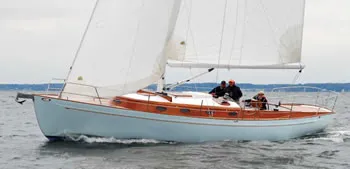
Photos by Ralph Naranjo
The Annapolis Boat Show, held each October in Annapolis, Md., belongs on every sailors bucket list-whether you intend to buy anything or not. Featuring a higher-than-usual glamour quotient, last years show felt like a fashion show in reverse. All the new boats sat dockside as potential buyers walked the runway. This time, PS Technical Editor Ralph Naranjo went to the show with a specific purpose: to seek out design trends that could have a significant impact on how we think about sailboats, and how we use them. Almost immediately, his eye was drawn to a part of the sailboat that has seen some of the most dramatic design changes in recent years, the bow.
What quickly jumped out was that race-boat designers long-running obsession with near vertical plumb bows, a shape that allows designers to squeeze maximum waterline length into a hull, has trickled down even to boats generally regarded as cruising boats. This raised the question: Is this race-boat style stem truly advantageous to a cruising boat?
To fully understand the implications of this shift, it is important to recognize that a plumb stem and long waterline arent the only design factors that make a sailboat go fast. It is the combination of fine entry, deep fin keel, light displacement, big rig, and large sail area that are the underpinnings of speed. Without these attributes, the advantages of a long waterline wont be fully leveraged.
In fact, heavy-displacement, plumb-bowed cruising boats have always been wetter in a seaway and slower in light air. So when it comes time to picking your preferred cruising boat design, don’t be sidetracked solely by what works well (or looks slick) on a race boat. Be sure to consider all the other important factors linked to the overall mission of the pointy end of a sailboat.
Racing sailors often see less as more, especially when it comes to foredeck clutter and hardware that they seldom use. They prefer their work space to be free of protrusions that can become a trip hazard or snag the foot of an asymmetrical as it regularly fills and collapses in a rolling seaway. In short, a windlass, horn cleats, and other laudable anchoring appendages are the last thing the bowman wants in his or her domain. Sprits, retractable poles, sheets, guys, and halyards are the tools of their trade.
During last summers Newport to Bermuda Race, a sloop with a built-in retractable sprit slammed into something in the water (or perhaps jammed the clew of the sail into a wave face), and the impact broke the outhaul tackle on the pole and sent the butt-end flying backward into its hull recess with enough force to splinter the bulkhead. Had a crew been in the V-berth area where the pole retracted, they very well could have been seriously injured or even killed by the blow, which would have been similar to the thrust from of a jousters lance at full gallop.
The lesson here is that appendages projecting from the stem of the boat can improve sail handling, but they are also vulnerable to unanticipated loads. Thats why a fail-safe locking mechanism and other fuse-like failure point that breaks before serious hull damage occurs should be engineered into the design in order to lessen the chance of harm to the crew or boat. For example, building a sprit pole thats strong enough to handle bending loads is a good idea, but building one thats strong enough to act like a crowbar capable of ripping open a hole in the topsides isn’t.
For cruising sailors, the least desirable characteristic of a plumb stem is its detrimental effect on deploying and retrieving ground tackle. Racers less frequently go through the anchoring ritual, but cruisers see it as being as necessary as raising and lowering sail.
During Naranjos Annapolis dock walk, he noticed that a few, freshly popped-from-the-mold sailboats were already sporting anchor dings in their gelcoat. These chips and scrapes were apparently sustained during show delivery stopovers. Other plumb-bow designs prevented such trauma by perching anchors on long bow roller protrusions that ranged in length and style from sensible, elegant fabrications to oversized extensions ready to snag a marina neighbors backstay. The bottom line: If deploying and retrieving an anchor is part of your regular routine, straight-stem sailboats can present a challenge.
Setting up bow-rollers with the right geometry and structure for handling anchors is an important consideration, and many cruising-boat designers give considerable attention to such details. They recognize that anchoring is part of a cruisers preferred lifestyle, and an efficient way to handle ground tackle is a priority. The more time you spend at anchor, the higher the likelihood that youll be caught by bad weather midway through a good nights sleep, something that is often forgotten when comparing deck hardware details in the still waters of the Annapolis basin. Suffice it to say that the gleam of a bow-roller says almost nothing about its utility when retrieving or re-setting an anchor at night on a dark, bucking foredeck.
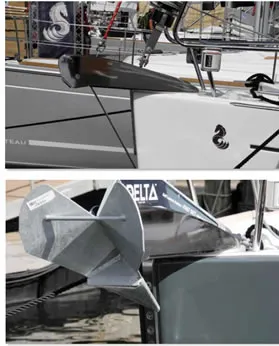
A number of boats Naranjo looked over seemed to follow a theme of trying to hide the windlass from view and make the bow roller as unobtrusive as possible; a few simply left out these essential pieces of gear altogether. This might be acceptable to those who daysail or marina-hop and have no inclination to anchor, but relying on a sailboat without good anchoring capability is like ignoring the importance of carrying fire extinguishers.
Ground-tackle handling needs to be a hands free, up or down exercise where a stout roller offers a fair lead for chain and rope headed to an anchor windlass. The rode should strip from the drum or chain gypsy without coaxing, and as the anchor breaks the surface, pitching wont cause it to pendulum-swing into the stem or topsides. Collision clearance, or the amount of offset between the boat stem and the anchor roller, depends upon how plumb-bowed the design happens to be.
Excess separation can be just as undesirable as too little offset-but for different reasons. When an anchor, roller, and sprit-fastening hardware are perched well forward of the stem, the weight accelerates the vessels pitching moment. Also, the lengthy extension is harder to support, and the effect of even a minor collision can be significant.
Finally, when anchored, the bobstay and whisker stays can become obstructions that the rope or chain will chafe against. This is especially a nuisance when light wind and a strong current prevent the boat from streaming in line with the rode. Careful use of a snubber-line and chafe gear can lessen this nuisance. The snubber-line should lead directly to an on-deck chock and cleat in order to lessen the pitch-inducing leverage caused by placing anchor rode loads at the end of a long sprit.
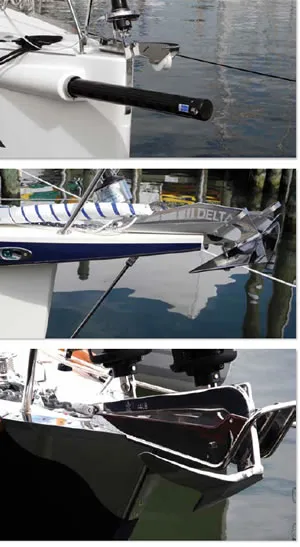
A Vulnerability
Bow sprits have long been a feature on traditional craft. They add extra sail area to help coax heavy-displacement hulls with relatively short rigs through the water. Today, higher sail-area-displacement ratios and taller rigs have lessened the need to spread working sail plans beyond the bow. This arrangement has been so successful that sailors have forgotten about the vulnerability of jutting jib booms, corroding bobstay fittings, and other risks linked to projecting parts of the rig and sail plan beyond the stem or stern.
An important lesson was driven home a few years ago when the Pride of Baltimore II was sailing in the Baltic and a fitting that attached the bobstay to the stem pulled free. In a chain reaction, the bobstay went slack, resulting in an abrupt loss of tension in the headstay, causing the foremast to break and the mainmast to topple. Appendages, whether they are designed for sail-carrying or are solely for anchor hoisting, are vulnerable projections.
Anchor sprits on modern, plumb-bowed sailboats are usually one-act ponies; they exist solely to eliminate hull bashing during anchor deployment and retrieval, or, on racing boats, as projections for reachers, code sails, and asymmetric spinnakers. From the endless-line furler tests we have conducted at Practical Sailor, weve found that it makes sense that bowsprits be suited for both jobs-handling anchors as well as a furling code sails, or asymmetrical spinnakers.
A number of the boats on display in Annapolis featured a small strut or mini-bobstay that could also dutifully serve as a forward tack point for a light-air headsail, asymmetric-spinnaker, or endless-line furler. Its important to keep in mind that when a boat is anchored, the loads on the sprit are downward, but when a headsail or asymmetric spinnaker is tacked to the sprit, the pull is upward. Both uses have a side-load component, caused by either the angle of pull of the anchor rode or the heeling-moment generated by the sail. Consequently, its important to make sure that there is enough reinforcement to support all potential force vectors.
When it comes to engineering these structures, it is also best that they are not integral to the primary support of the mast. That means that a headstay fixed six feet forward of the stem on a sprit supported by a bobstay and whisker stays should not be the main wire or rod supporting the mast. Offshore, these platform-like projections endure immense torment when beating into a building sea. To circumvent the risk this can pose to the mast, riggers often connect a forestay at the stem head that runs to, or nearly to, the masthead, so damage to a long bowsprit will not cause the rig to topple over the side.
We were glad to see that not all boats at the show came with dreadnaught-like plumb bows. Sabre, Tartan, Hallberg-Rassy, Hylas, Island Packet, Catalina, and others continue to hold on to the idea that a little overhang goes a long way to solving the anchor-handling dilemma. The modest overhang on these boats allows the bow roller to nestle closer to the stem and eliminate the need for the narwhal-esque projection required by many high-freeboard, plumb-bow designs.
Catamarans solve the ground tackle handling issue by putting a structural cross-member to good use and mounting a heavy-duty roller on the vessels centerline. Trimarans face the same challenge as monohulls and must project a roller away from the center hull, if a plumb bow or reverse-sloping stem is part of the design.
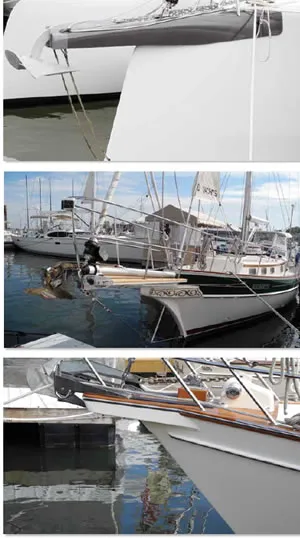
Conclusion
As we have often pointed out, yacht design is a cascade of compromises and tradeoffs that allow one attribute to be emphasized at the expense of another. The important consideration for every boat owner and potential boat buyer is to recognize what is in play with each tradeoff and whether or not the upside is in your best interest and the downside is not too costly. When style enters the equation, and the pressure of the fashion show takes hold, the savvy sailor must retain a firm hold on his or her priorities, and make decisions with less form and more function in mind.
If youre a performance-oriented sailor, a fine entry, plumb-bowed, sprit-adorned speedster will certainly liven up the day-especially if the hull sections and prismatic coefficient provide enough lift and buoyancy forward to keep the bow from submarining.
The best way to get a feel for such dynamics is to go for a test sail in bit of breeze and see how the sailboat behaves on and off the wind. Be sure to consider the needs of the crew on the foredeck. Are the plumb bow, deck layout, and other attributes of the bow design helpful or hindering during a spinnaker-takedown, or when the boat is overpowered by an 0300 squall?
From what weve seen and experienced, theres valid justification for plumb bows on race boats, especially when rating rules and marina fees enter the equation. However, if youre a cruising sailor, there are both sail and ground-tackle handling to consider. And its no surprise that we believe that sprit poles housed in the hull are not an offshore cruisers best friend.
In our view, a short projection from the stem that provides support for a bow roller and also acts as the tack point for a light-air headsail or asymmetric spinnaker makes sense. Keep in mind that when it comes to sprits, less can be better than more, and when it comes to sailing performance, you need to look at displacement as well as sail area, and realize that the lower the sail-area-displacement ratio becomes, the more often the diesel will be called into action.
Plumb bows may look fast, but looking fast and going fast are two different things. Whats sacrificed aboard a straight-stem cruiser is the ability to install a roller that projects from the stem. Pounding into a seaway with a projection forward of the stem can lead to problems.
For years, Asian-built CTs, Sea Wolfs, and similar clipper-bowed cruisers set off for Polynesia and arrived in Tahiti with bowsprits sheared clean off the teak walkway affixed to the top of the sprit. Bluewater isn’t compressed by a plunging bow-all of the load is imposed on the sprit and the anchors perched at the end.
In some ways, the straight stem has become the alloy-wheel of the marine industry. Automotive engineers know that its whats under the hood that counts, and for sailors, its whats below the waterline and above the deck that seal the deal. Looking fast may be a marina upside, but its how a design factor contributes to a vessels mission that really counts.
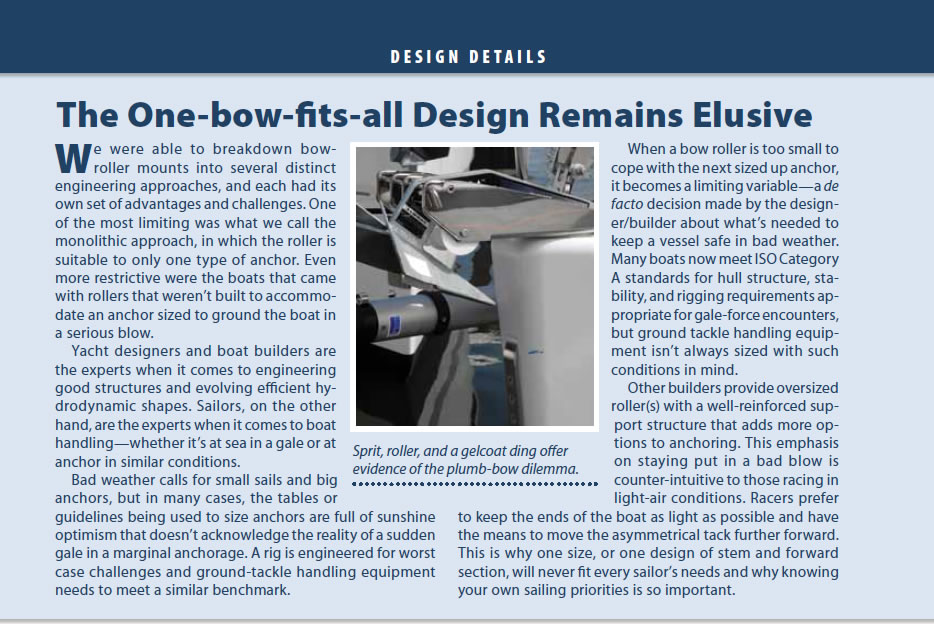

































I’m I’m sorry BUT Which boats arrived with clipper bows arrived with their bowsprit torn off? As I seem to see many boats KNOWN for their seaworthy saltiness with long bowsprits that sailed around the world with no damage at all to their bows. Both of Lin and Larry Pardey’s boats had long bowsprit and cutter riggs and sailed through hurricane force gales and 20-30ft seas no damage to their bowsprit at all. AND NO the spirt is NOT there just so you have a place to drop a anchor chain it’s there to he more head sail area. And the design of a clipper bow vs a more vertical plumb bow is not about the bowsprit or anchoring. And you gave little if any heed to the pros and cons of the hull design and it’s effect on how a boat cuts through waves. You did touch on why light flat bottomed wide stern fin keel race boats have plum bows but except for saying clipper bows give you a place to hang a anchor you ignored the pros of how the entry of a clipper bow on a heavy displacement boat can make for a more comfortable and DRYER ride for cruisers who also prefer to sail more upright then healed at 45degrees for days when making passages. I suppose your talking to the boat show new boat buyers as the new production boats all seem to be designing based on the
Same fat stern and flat bottom bolted on fin keel plumb bow designs (in fact many having such a wide stern then need two rudders and two wheels) that leaves out a lot of older salty blue water boats. (And Ted Gozzard would have a few words to say about your analysis of clipper bows and long bowsprits)